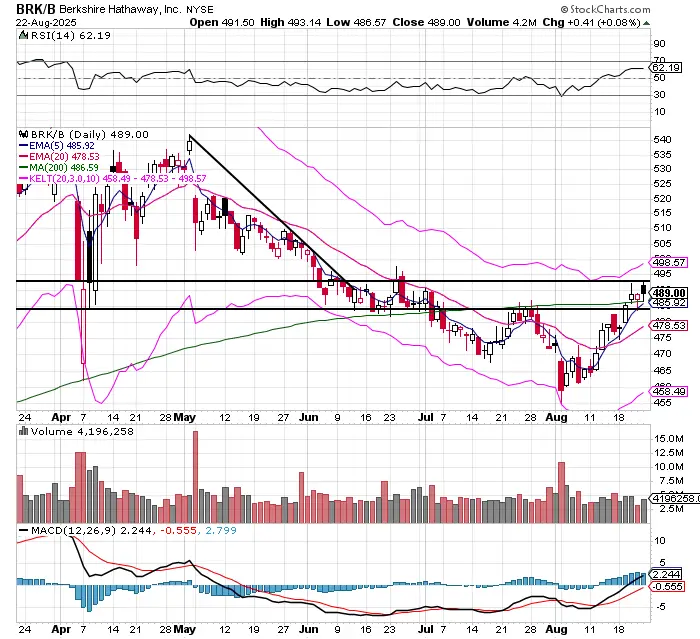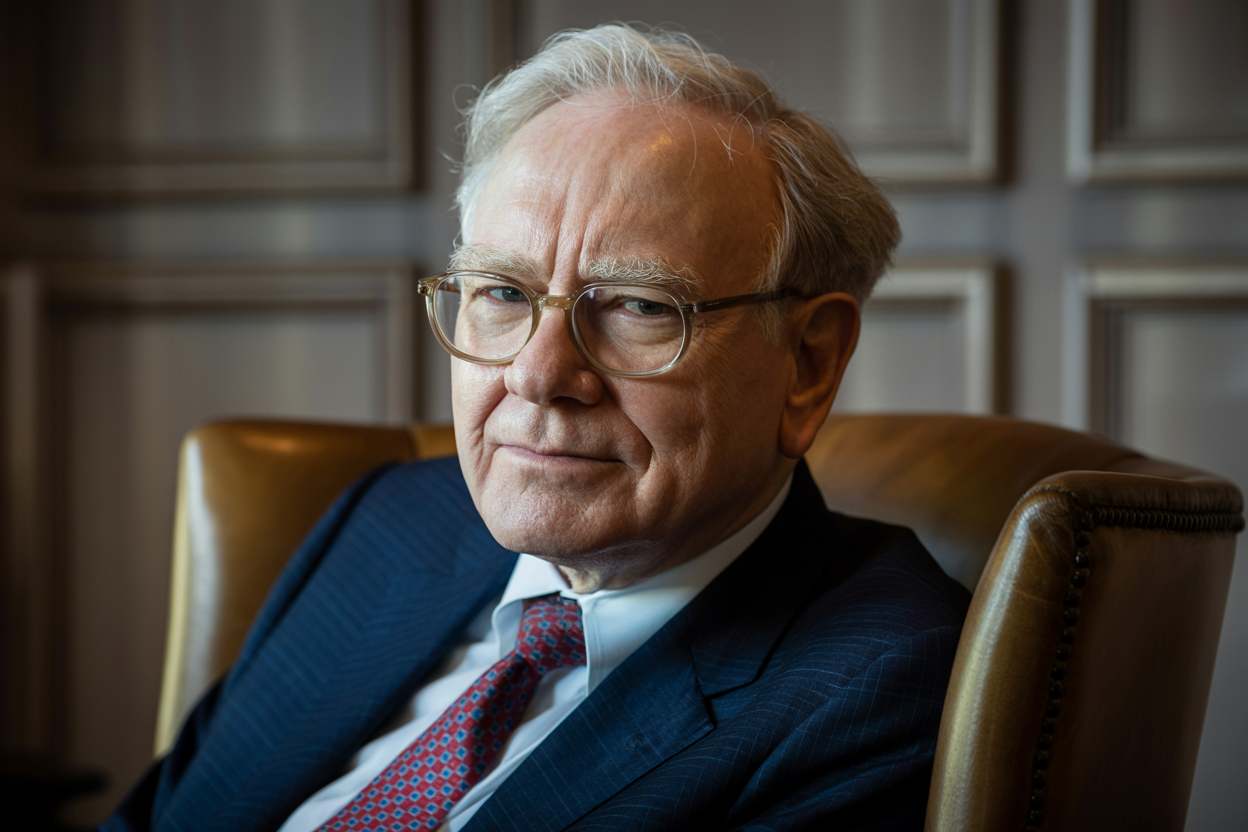Warren Buffett’s Berkshire Hathaway stands at a fascinating crossroads. As the legendary investor approaches his 95th birthday and prepares for a leadership transition, his corporate conglomerate has amassed an unprecedented cash position while trading at what analysts consider significantly undervalued levels.
For value investors seeking quality companies at attractive prices, Berkshire presents a compelling opportunity that combines safety, growth potential, and strategic optionality right now based on its fundamental valuation versus current cash and future cash flows. Let’s examine Berkshire Hathaway.
1. Record $344 Billion Cash War Chest: Ultimate Financial Flexibility
Berkshire Hathaway holds an extraordinary $344 billion in cash, cash equivalents, and short-term Treasury bills as of the first quarter 2025. To put this staggering figure in perspective, this represents more liquid assets than technology giants Apple, Amazon, Alphabet, and Microsoft have combined. This isn’t idle money sitting in low-yield accounts – approximately 88% of this cash pile is strategically invested in US Treasury bills, generating roughly $12 billion annually in risk-free returns guaranteed by the US government.
This massive war chest has more than doubled since 2024, growing from approximately $167 billion to its current record level. While some critics view this as a sign that Buffett can’t find attractive investment opportunities, value investors should see it differently. This cash position provides Berkshire with unparalleled financial flexibility and optionality. When market conditions inevitably turn and attractive opportunities emerge, Berkshire will have the firepower to make significant acquisitions or investments that competitors won’t match.
The strategic value of this cash position becomes even more apparent when considering Buffett’s famous philosophy of being “greedy when others are fearful.” History shows that the best investment opportunities often arise during market downturns when companies need capital and assets trade at discounted valuations. Berkshire’s massive cash reserves position it perfectly for these moments. This also means that Berkshire can be bought at only three times cash on hand with its $1.06 trillion market cap, which is a staggeringly low valuation price.
2. Trading 31% Below Fair Value Despite Strong Fundamentals
As of August 2025, several valuation metrics view Berkshire Hathaway as significantly undervalued. The stock trades at a price-to-earnings ratio of approximately 23.23 and a price-to-book ratio of 1.57, both of which signal improved valuation compared to the broader market. Notably, the current price-to-book ratio of 1.57 has increased by about 4.7% from its 12-month average of 1.50, as the stock has become more attractive to value-oriented investors in recent months.
Most compelling is the analysis from financial experts using the Peter Lynch fair value formula, which estimates that Berkshire Hathaway is currently trading about 52% below its fair value. This substantial discount suggests significant upside potential for investors willing to buy at current levels. For a company of Berkshire’s quality and diversification, such a discount is relatively rare and has historically presented excellent entry points for long-term investors.
The price-to-book ratio is particularly relevant for evaluating Berkshire because the company operates as a conglomerate where net income can fluctuate significantly based on its stock and investment portfolio performance. Book value provides a more stable foundation for valuation, representing the underlying worth of Berkshire’s diverse collection of wholly-owned businesses and investment assets.
Current valuation multiples also compare favorably to historical ranges. The company’s P/B ratio of 1.51 sits near the lower end of its historical trading range. It provides investors access to a premier collection of businesses and one of the most successful capital allocation track records in investment history.
3. Diversified Operating Businesses Driving 27% Earnings Growth
Beyond its investment portfolio, Berkshire Hathaway operates a diverse collection of wholly-owned businesses that generated impressive results in 2024. Berkshire Hathaway’s operating earnings for the first six months of 2025 were approximately $20.8 billion, representing an 8.8% decrease compared to the same period in 2024. For the second quarter alone, operating earnings were $11.16 billion, down about 4% year-over-year.
Berkshire Hathaway’s operating earnings illustrate the diversity of its business. In the second quarter of 2025, insurance operations, including GEICO and related subsidiaries, comprised about 48% of total operating earnings. The railroad business, BNSF, and Berkshire Hathaway Energy contributed roughly 30%, while manufacturing, retail, service companies, and other smaller enterprises accounted for the remaining 22%. This breakdown showcases the company’s balanced mix of revenue sources across multiple industries.
This focus on operating earnings rather than GAAP-mandated earnings provides a clearer picture of Berkshire’s fundamental business performance. As Buffett has repeatedly emphasized in shareholder letters, operating earnings better reflect the actual performance of Berkshire’s business units rather than the often volatile changes in the value of the company’s stocks and bonds.
The stability and growth of these operating businesses provide Berkshire with consistent cash generation that can fund future investments, acquisitions, or capital returns to shareholders. This diversified revenue stream reduces dependence on any single industry or economic cycle, making Berkshire more resilient during challenging financial periods.
4. Leadership Transition Creates Temporary 10% Discount Opportunity
The announcement of Buffett’s planned retirement has created what appears to be a temporary valuation discount. Since news broke of his stepping down as CEO, Berkshire’s stock has declined approximately 10%. Importantly, this decline stems almost entirely from a contracting valuation multiple rather than deteriorating business fundamentals.

Investor sentiment reflects concerns about Berkshire’s performance without its legendary leader. However, this reaction may create an attractive entry point for long-term investors. Buffett has spent decades building a strong management culture and developing capable successors, with Greg Abel positioned to take over leadership responsibilities.
The market’s focus on Buffett’s departure overlooks the institutional strength he has built within Berkshire Hathaway. The company’s decentralized management structure, conservative financial principles, and focus on long-term value creation should persist regardless of who occupies the CEO position. The businesses within Berkshire’s portfolio have experienced management teams and don’t rely on day-to-day direction from Omaha headquarters.
This leadership transition discount represents a classic example of short-term market sentiment creating opportunities for patient value investors. Those willing to look beyond immediate concerns about management changes can benefit from acquiring shares in a premier business collection at temporarily reduced prices.
5. Buffett’s Strategic Selling Signals Future Buying Power
Rather than viewing Buffett’s recent selling activity as a negative signal, value investors should interpret it as strategic positioning for future opportunities. Since mid-2023, Berkshire Hathaway has reduced its Apple stake by about 69%, trimming its holdings to approximately 280 million shares valued at over $64 billion as of mid-2025.
At the same time, the company has decreased its Bank of America holdings by roughly 30%, with Bank of America now representing about 11% of Berkshire’s portfolio as of the latest filings. The company has also engaged in net selling for 11 consecutive quarters, building its cash reserves rather than making new investments.
Additionally, Berkshire hasn’t repurchased its shares for three consecutive quarters, marking the first time since 2018 that the company has abstained from buybacks for an extended period. This pause in share repurchases suggests that Buffett believes current stock prices exceed his conservative estimate of intrinsic value, demonstrating his disciplined approach to capital allocation.
This selling activity shouldn’t be interpreted as pessimism about the economy or stock market. Instead, it reflects Buffett’s methodical approach to value investing and his willingness to take profits when assets become fully valued. The proceeds from these sales are building Berkshire’s ammunition for future opportunities when more attractive valuations emerge.
History shows that Buffett’s most successful investments often occur during market downturns when quality assets trade at discounted prices. By building cash reserves now, Berkshire is positioning itself to capitalize on these inevitable opportunities. The company’s patient approach to capital allocation has generated superior long-term returns precisely because management refuses to chase overvalued assets.
Conclusion
Berkshire Hathaway currently presents a unique value proposition that combines the safety of substantial cash reserves, the growth potential of diversified operating businesses, and the opportunity of temporarily discounted valuations.
The combination of record financial flexibility, strong fundamental performance, and market concerns about leadership transition has created what appears to be an attractive entry point for long-term investors.
For those seeking exposure to a premier collection of businesses managed with time-tested investment principles, Berkshire Hathaway offers a rare opportunity to invest alongside one of history’s most successful capital allocators at what may prove to be compelling valuations. Berkshire is Warren Buffett and Charlie Munger’s ultimate portfolio of companies built over fifty years. What’s a better investment than that?
